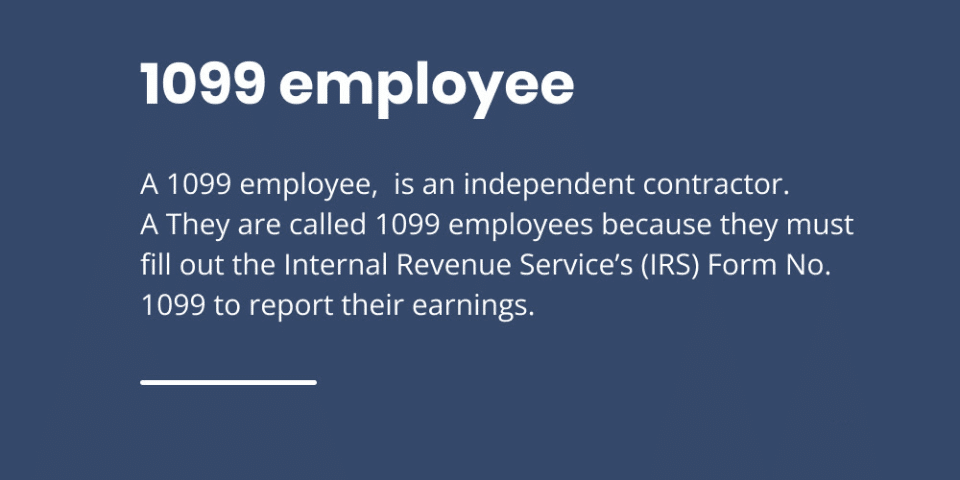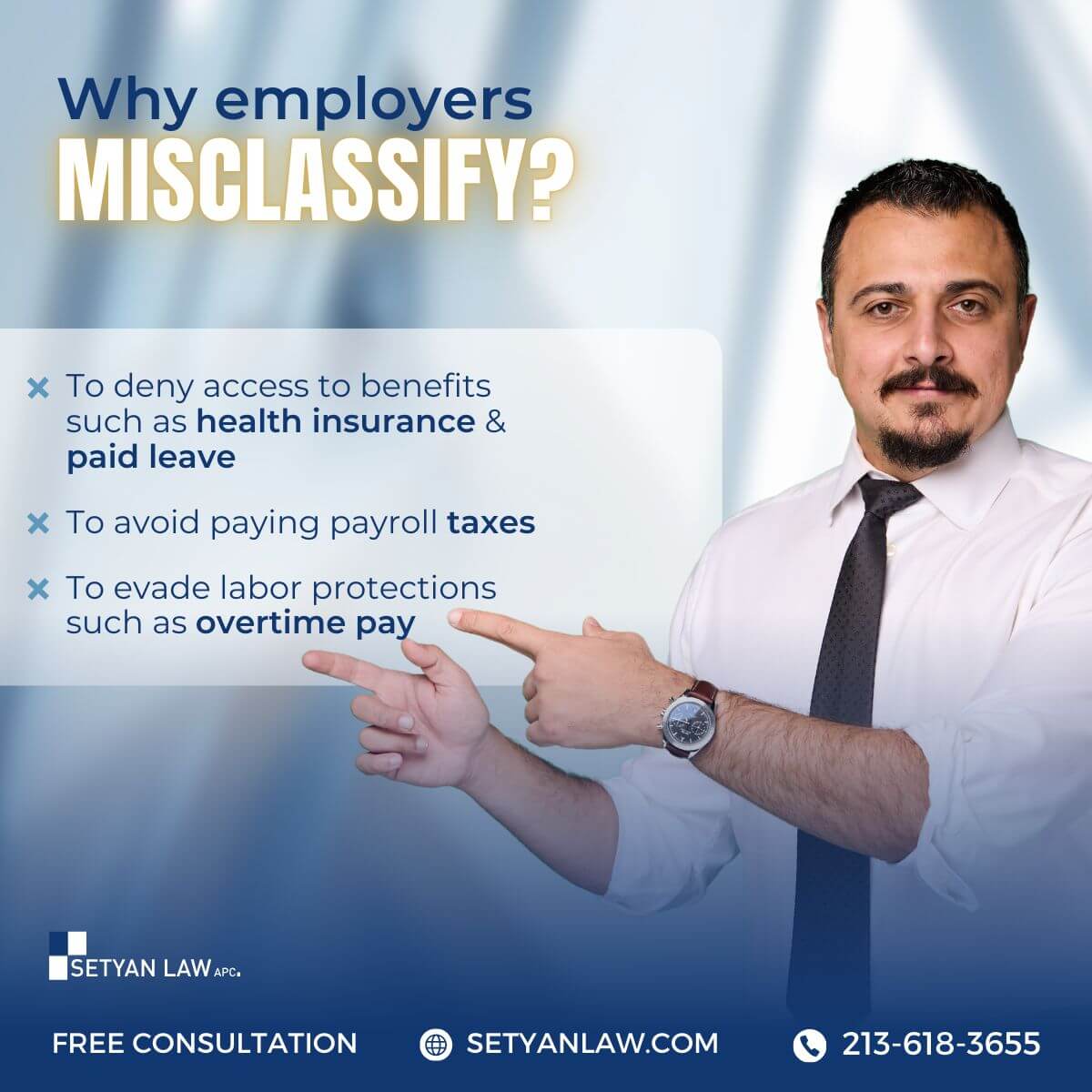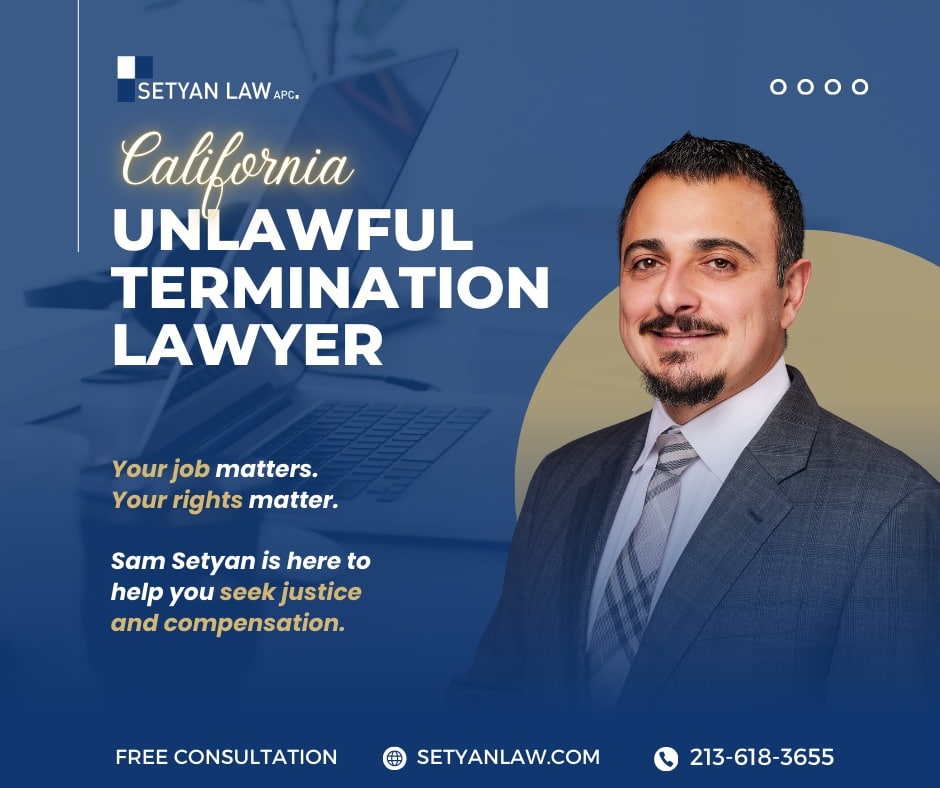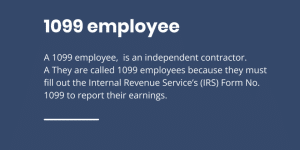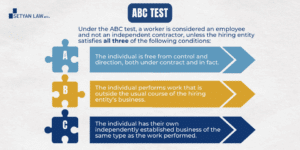Updated October 13, 2025
`
Misclassification is The Most Common Labor Code Violation in California
Employee misclassification occurs when an employer incorrectly categorizes workers as independent contractors rather than employees, thereby denying them employee protections and benefits while offloading business costs and risks . This fraudulent practice allows businesses to avoid complying with regulations on Unemployment Insurance, Workers' Compensation, Social Security, tax withholding, and minimum wage requirements .
The misclassification problem encompasses several variations. The most common form involves labeling workers as independent contractors when they should legally be employees . Additionally, employers sometimes incorrectly designate employees as exempt from overtime and minimum wage requirements when their duties and pay don't meet exemption criteria . Other variations include misclassifying full-time workers as temporary or part-time to avoid offering benefits, improperly categorizing workers as unpaid interns, or incorrectly labeling workers as volunteers in non-profit settings .
Understanding the distinction between employees and independent contractors is fundamental. Employees are generally individuals who perform services where the business controls what will be done and how it will be done . Meanwhile, true independent contractors are people who are in business for themselves, making all important decisions about running their business, including what goods or services to sell, setting prices, and marketing their services .
The consequences of misclassification are substantial for workers. Misclassified employees lose access to essential benefits and legal protections including overtime pay, workers' compensation, employer contributions to Social Security, Medicare, unemployment insurance, health insurance benefits, paid sick leave, and protection against discrimination . Furthermore, these workers must pay additional self-employment taxes that would normally be shared with or paid entirely by employers .
For employers, misclassification creates significant legal and financial risks. Businesses may face tax liability for unpaid payroll taxes, steep penalties, and legal action from employees seeking back wages and benefits . Companies caught misclassifying workers can be required to pay millions in fines, back pay, and suffer reputational damage . Notably, in a recent case, a gig economy customer support company was required to pay USD 2.00 million to 250 misclassified workers, plus almost USD 1.00 million in penalties, and was permanently banned from doing business in Washington D.C. .
Proper classification is essential because the determination affects tax obligations, benefit eligibility, and legal protections. Though avoiding taxes through misclassification might seem tempting to some employers, those wishing to comply with government regulations must submit correct classifications .
Employee vs Independent Contractor
The distinction between employees and independent contractors represents a critical legal boundary in employment law. According to the IRS, an employee is defined as someone who performs services where the business controls what will be done and how it will be completed . In contrast, independent contractors are self-employed individuals who provide specific services for an agreed-upon fee during a particular timeframe, maintaining control over when and how they complete work .
Federal tax authorities use a three-part test to determine proper classification. This test examines behavioral control (whether the company directs how work is performed), financial control (how payment and expenses are handled), and relationship type (existence of contracts, benefits, and ongoing nature of work) . Significantly, the test considers the entire relationship rather than any single factor in isolation .
Key differences exist across multiple dimensions. For behavioral control, employees typically have their schedules determined by employers, whereas independent contractors control their own time . Under financial control considerations, employees receive set wages with taxes withheld, while contractors set their rates and handle their own tax obligations . Relationship factors show employees often receive benefits like health insurance and paid leave that contractors do not .
State laws sometimes implement additional classification methods. California's ABC test, for instance, presumes workers are employees unless three specific conditions are simultaneously satisfied . This test requires that: (1) the worker is free from control in performing work, (2) the work is outside the hiring entity's usual business, and (3) the worker is customarily engaged in an independently established trade .
Correct classification matters substantially since tax and legal obligations differ significantly between these categories. Employers must withhold income taxes, Social Security, and Medicare taxes from employee wages, plus pay unemployment tax . These obligations do not apply to independent contractor payments .
Misclassification litigation has increased substantially with the rise of the gig economy and sharing platforms . Companies frequently misclassify workers to avoid costs associated with employment taxes, benefits, and legal protections . In response, both federal and state agencies have intensified enforcement efforts against improper classification practices to protect worker rights .
Why Does Employee Misclassification Happen?
Studies estimate that approximately 30% of employers misclassify their employees as independent contractors . This widespread practice occurs for several key reasons, ranging from genuine confusion to deliberate attempts at cost reduction.
Lack of awareness
Many cases of employee misclassification stem from employers' inadequate understanding of classification requirements . Different countries have varying definitions and criteria, making compliance particularly challenging for businesses operating across multiple jurisdictions . Consequently, employers frequently misinterpret complex regulations or overlook critical requirements that determine whether a worker qualifies as an employee rather than a contractor . Moreover, shifting workforce dynamics have blurred traditional distinctions between employment categories, further complicating proper classification decisions .
Intentional cost-cutting
Businesses often deliberately misclassify workers to reduce expenses. Employers can save between 20% to 40% on labor costs through misclassification . A 2013 Treasury Inspector General report concluded that employers save approximately $3,710 per employee earning an annual income of $43,007 when they misclassify them as independent contractors . These savings result primarily from avoiding:
- Social Security and unemployment insurance taxes
- Medicare contributions
- Workers' compensation premiums
- Employee benefits like health insurance and paid leave
Industry norms
Misclassification has become especially prevalent in growth sectors including home care, janitorial services, trucking, delivery, construction, hospitality, and app-based gig economy jobs . In these industries, the practice often becomes normalized as competitors gain unfair advantages through misclassification, pressuring other businesses to follow suit . This creates an uneven playing field where law-abiding businesses face competitive disadvantages because they incur legitimate expenses for unemployment insurance and workers' compensation .
Complex legal rules
Perhaps the most significant factor contributing to misclassification is the complexity and inconsistency of worker classification standards. The Department of Labor, Internal Revenue Service, and individual states each maintain different legal tests for determining worker status . Furthermore, classification laws continue to evolve, with frequent changes at both federal and state levels . This regulatory patchwork creates substantial confusion, essentially requiring employers to navigate multiple distinct classification frameworks simultaneously . Thirty-three states currently use the "ABC test" or variations of it, whereas federal agencies employ different standards focused on economic reality or common law principles .
Consequences of Misclassifying Workers
Misclassifying workers exposes employers to substantial legal and financial repercussions across multiple fronts. These consequences can impact businesses long after the initial violation occurs.
Legal penalties and fines
The financial penalties for employee misclassification vary by jurisdiction but can be severe. In Europe, fines can reach up to €500,000 per misclassified worker . In the United States, employers face interest on delinquent unemployment insurance contributions at an annual rate of 24% . Workers' compensation violations can result in fines up to $500 for every day of non-compliance, with minimum penalties of $10,000 . Officers who knowingly fail to obtain insurance may face Class 4 felony charges . Likewise, businesses that willfully misclassify workers in California can incur civil penalties ranging from $10,000 to $25,000 per affected employee .
Back pay and benefits
Employers found guilty of misclassification must typically provide back wages covering minimum wage violations, overtime pay, and other unpaid compensation . The Fair Labor Standards Act allows workers to file private suits for back pay plus an equal amount as liquidated damages . Benefits arrears often include health insurance contributions, retirement plan payments, and paid time off . For example, a therapy provider in California was held liable for approximately $9 million in damages after misclassifying 1,280 therapists .
Tax liabilities
Tax consequences are equally substantial. Employers may be responsible for unpaid payroll taxes, including both employer and employee portions of FICA taxes . Additional penalties include up to 3% of misclassified employees' wages, 100% of unpaid FICA taxes, and up to 40% of FICA taxes that should have been withheld . The IRS can hold employers liable for employment taxes plus interest accrued from when those taxes should have been deposited .
Reputational damage
Beyond financial penalties, misclassification scandals tarnish company reputation, eroding customer and investor trust . Negative publicity from audits or lawsuits deters independent contractors from working with the company . Such damage affects businesses' ability to attract and retain top talent . The ride-hailing company Bolt exemplifies this risk—following court rulings, they were forced to reclassify drivers and pay approximately £200 million in claims and fines .
Loss of employee trust
Compliance issues signal potential red flags about business practices, prompting contractors to question what other challenges might arise . Non-compliance diverts valuable resources from efforts to stay competitive . Even a single instance of worker misclassification can create a ripple effect, leading top independent contractors to avoid working with the company . Independent professionals place high value on trust and reputation; any compliance missteps could push them to seek opportunities elsewhere .
How to Avoid Employee Misclassification
Preventing employee misclassification requires systematic approaches and clear policies. Nationally, estimates indicate 10 to 30 percent of employers misclassify their employees as independent contractors . Implementing proper preventative measures helps businesses avoid substantial penalties and legal complications.
Use classification checklists
Classification checklists provide a structured framework for evaluating worker status. The IRS uses three primary categories when classifying workers: behavioral control, financial control, and relationship type . Businesses should document each factor considered in classification decisions . These checklists help ensure consistent application of classification criteria across the organization. The Department of Labor offers frequently asked questions (FAQs) that can assist in developing standardized assessment tools .
Train HR and managers
Properly educating human resources staff and managers about classification requirements is crucial. Training should cover the legal distinctions between employees and independent contractors . Designate specific periods annually to evaluate classification practices . Additionally, promote standardization to ensure all departments apply consistent classification criteria . This approach helps prevent inadvertent misclassification due to inconsistent practices across different business units.
Review contracts regularly
Job descriptions and responsibilities often change over time, potentially affecting classification status. Regular internal audits help identify classification errors before they become problematic . As noted by legal experts, "job description creep" or "supervisory creep" can gradually transform contractor relationships into employee relationships . Therefore, schedule periodic reviews of worker classifications, particularly when responsibilities change substantially.
Consult legal experts
Given the complexity of classification laws, seeking professional guidance is advisable for uncertain cases. Legal counsel can provide tailored advice on specific classification scenarios . This becomes particularly important when operating across multiple jurisdictions with varying standards . Legal experts can help navigate the intersection of federal, state, and local classification requirements.
Use Employer of Record (EOR) services
Employers of Record can significantly reduce misclassification risks, particularly for international operations. EORs serve as legal employers on behalf of companies, handling compliance with local labor laws . They bring specialized expertise in classification requirements across jurisdictions . Furthermore, EORs establish clear classification policies, detailed documentation, and consistent internal audits to eliminate ambiguity . This structured approach shields companies from penalties, back-tax liabilities, and reputational damage .
How to Fix a Misclassification Mistake
Addressing worker misclassification promptly after discovery helps minimize penalties and legal exposure. Once identified, corrective action should proceed through systematic steps.
Identify misclassified workers
Begin by reviewing team members' job duties, work agreements, and the level of control exercised over their activities . This assessment should evaluate whether workers meet proper employee classification criteria under applicable laws. Documentation becomes critical during this phase—keep records of all factors considered in the original classification decision .
Reclassify and update records
Upon identifying misclassification, immediately correct the worker's status . This process involves cooperating with relevant tax authorities, updating employment contracts, and revising all documentation related to the worker's status . Communicate changes transparently to affected workers, explaining their new classification and implications .
Pay owed wages and taxes
Calculate and disburse all unpaid compensation, including back wages, benefits arrears, leave entitlements, and overtime . Subsequently, address tax obligations by paying back taxes to appropriate authorities . These payments often include both employer and employee portions of payroll taxes plus accrued interest .
Notify tax authorities
In the United States, employers can apply for the Voluntary Classification Settlement Program (VCSP) . If eligible, this program allows businesses to correctly reclassify independent contractors while paying only 10% of employment taxes that would have been due for the previous tax year .
Seek legal advice
Given potential financial liabilities, consult legal experts who can evaluate corrective options . Professional guidance becomes particularly important as the Fair Labor Standards Act generally prohibits private settlements .
If you’re employed by a California employer, contact an expert Wrongful Termination Attorney first, for expert assistance regarding your case. Call today for a free and confidential consultation.
References
[1] – https://www.papayaglobal.com/blog/employee-misclassification/
[2] – https://velocityglobal.com/resources/blog/employee-independent-contractor-misclassification-guide/
[3] – https://www.bamboohr.com/blog/avoid-employee-misclassification
[4] – https://employerrecords.com/employee-misclassification-how-eors-prevent-it/
[5] – https://workmotion.com/employee-misclassification-risks/
[6] – https://www.genemarks.com/columns/worker-classification-rules-are-changing-employers-should-pay-close-attention-lawyers-say/
[7] – https://www.dol.gov/general/topic/wages/backpay
[8] – https://parsonsbehle.com/insights/avoiding-worker-misclassification
[9] – https://www.irs.gov/businesses/small-businesses-self-employed/independent-contractor-self-employed-or-employee
[10] – https://www.troxelfitchlaw.com/employee-misclassification-how-do-you-know-if-you-have-an-employee-or-independent-contractor-on-your-team
[11] – https://www.nelp.org/insights-research/independent-contractor-misclassification-imposes-huge-costs-workers-federal-state-treasuries-update-october-2020/
[12] – https://dol.ny.gov/employer-misclassification-workers
[13] – https://www.aoshearman.com/en/insights/recent-developments-in-us-worker-classification-rules
[14] – https://ides.illinois.gov/employer-resources/taxes-reporting/employee-misclassification.html
[15] – https://www.deel.com/blog/employee-misclassification-penalties/
[16] – https://www.applied-hcm.com/the-dangers-of-employee-misclassification/
[17] – https://www.withum.com/resources/the-federal-crackdown-on-worker-misclassification-understanding-the-stakes-and-taking-preventive-measures/
[18] – https://www.symmetry.com/payroll-tax-insights/the-real-cost-of-employee-misclassifcation
[19] – https://www.mbopartners.com/blog/misclassification-compliance/employee-misclassification-penalties/
[20] – https://www.mbopartners.com/blog/misclassification-compliance/how-compliance-issues-can-undermine-your-reputation-with-independent-contractors/
[21] – https://tax.thomsonreuters.com/blog/legal-expert-explains-dols-new-worker-classification-rule/
[22] – https://expressglobalemployment.com/blog/how-to-avoid-employee-misclassification-risk/
[23] – https://www.watsonnorris.com/a-comprehensive-guide-to-understanding-worker-misclassification
[24] – https://www.beeline.com/resources/guarding-against-misclassification-effective-strategies-to-avoid-worker-fines
[25] – https://www.omnipresent.com/articles/how-to-correct-employee-misclassification
[26] – https://parrottbenefitgroup.com/best-practices-for-reclassifying-employees-as-nonexempt/


